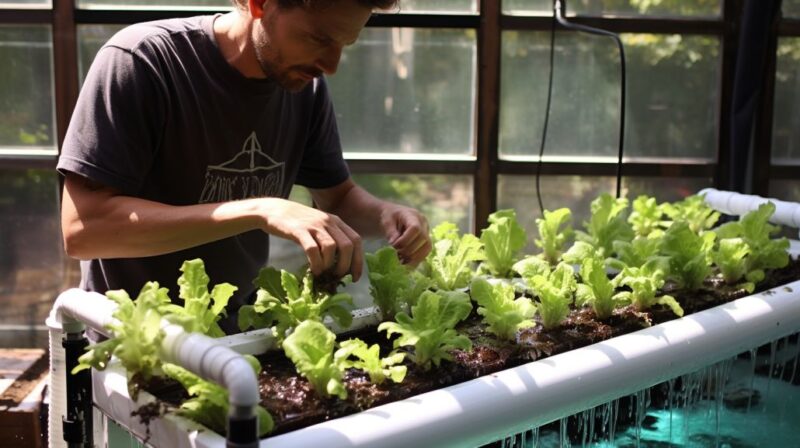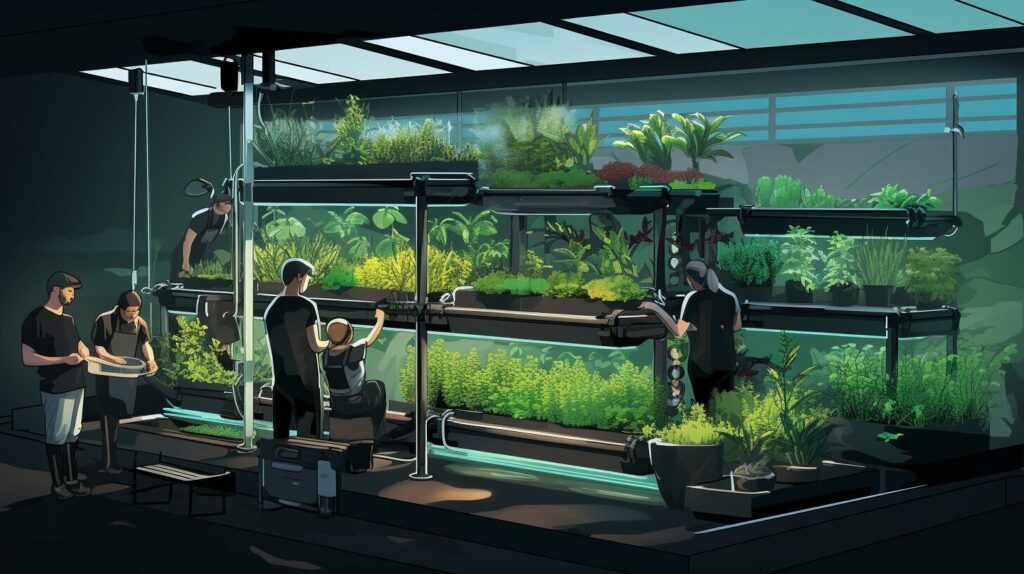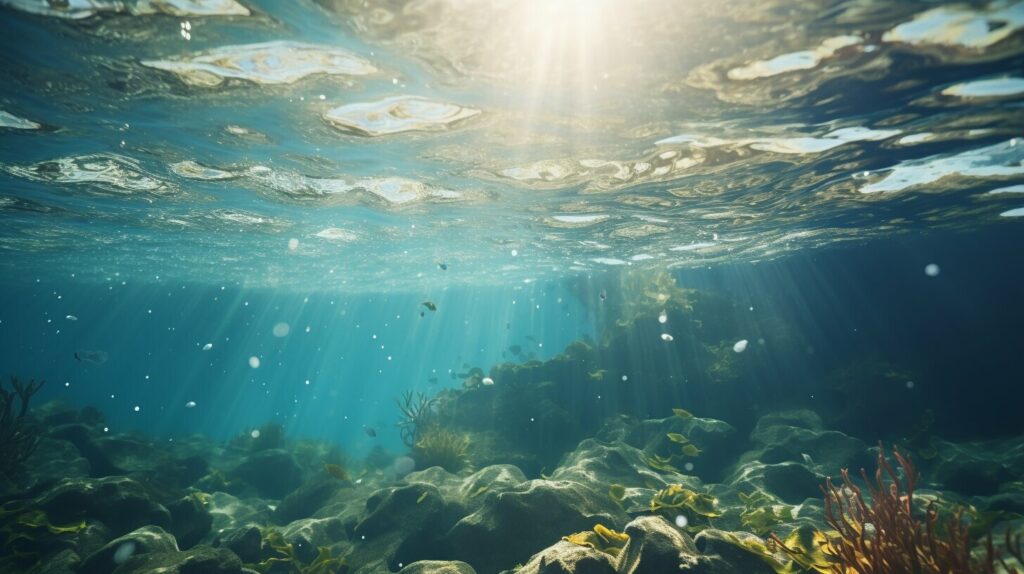This post may contain affiliate links and we may earn a small commission when you click on the links at no additional cost to you. As an Amazon Affiliate, we earn from qualifying purchases. You can read our full disclaimer here.
If you’re looking for a sustainable farming method that uses minimal water and chemical fertilizers and yields higher crop yields, then aquaponics might be the answer. But what is aquaponics, you might ask? Simply put, it’s a system that combines aquaculture (fish farming) and hydroponics (soilless plant cultivation) to create a mutually beneficial ecosystem.
In an aquaponics system, fish waste provides nutrients for plants, while the plants filter the water for the fish. This results in a closed-loop, eco-friendly system that requires less water and produces less waste than traditional farming methods.
Key Takeaways:
- Aquaponics is a sustainable farming method that combines aquaculture and hydroponics.
- An aquaponics system creates a mutually beneficial ecosystem, where fish waste is used as nutrients for plants and plants filter the water for the fish.
- Aquaponics requires less water and produces less waste than traditional farming methods.
How Does Aquaponics Work?
If you’re new to aquaponics, you may be wondering how this sustainable farming method actually works. Essentially, aquaponics combines aquaculture (fish farming) with hydroponics (growing plants in nutrient-rich water) to create a mutually beneficial ecosystem where both fish and plants thrive.
The key components of an aquaponics system include a fish tank, a grow bed filled with plants, and a water recirculation system. Here’s how it works:
- Fish are raised in the fish tank, where they produce waste (ammonia) through respiration and excretion.
- The waste-filled water is then pumped into the grow bed, where plants absorb the nutrients from the fish waste as they grow.
- As the plants absorb the nutrients, they filter the water and remove the harmful ammonia, converting it into nitrites and then nitrates, which are beneficial for the fish.
- The clean water is then returned to the fish tank and the cycle repeats, creating a self-sustaining ecosystem.
It’s important to maintain a balanced ecosystem in your aquaponics system to ensure the health of both the fish and plants. This means monitoring water quality, pH levels, and temperature, as well as ensuring the plants and fish are compatible with each other.
Types of Aquaponics Systems
There are several types of aquaponics systems, each with their own advantages and challenges:
| Type of System | Description |
|---|---|
| Media-based | Uses a grow bed filled with a growth medium such as gravel or clay pellets. Provides a stable environment for plant roots and is easy to maintain. |
| Nutrient film technique (NFT) | Uses a shallow trough to constantly flow nutrient-rich water over the roots of the plants. Ideal for small-scale systems and fast-growing herbs and leafy greens. |
| Deep water culture (DWC) | Plants are suspended in net pots above the fish tank, allowing their roots to grow directly into the nutrient-rich water. Provides maximum oxygen exposure for plant roots. |
When designing your aquaponics system, consider factors such as the size and location of your setup, the type of fish and plants you want to grow, and the availability of resources such as water and electricity.
Setting up an Aquaponics System
Are you interested in setting up your own aquaponics system but not sure where to start? Don’t worry, we’ve got you covered. Here is a step-by-step guide to help you get started:
Step 1: Choose the Right Location
The first step in setting up an aquaponics system is to choose the right location. Look for an area with good sunlight exposure, access to electricity and a water source, and a stable temperature. Avoid areas that are prone to flooding or have extreme temperature fluctuations.
Step 2: Determine the Size of the System
The size of your aquaponics system will depend on the available space, your budget and the amount of food you want to grow. A small system can be set up indoors using a fish tank and a grow bed, while a larger system may require an outdoor greenhouse or shed.
Step 3: Select the Appropriate Fish and Plants
The next step is to select the right fish and plants for your aquaponics system. Popular fish options include tilapia, trout, and catfish, while common plants grown in aquaponics include lettuce, herbs, and tomatoes. It is important to choose fish and plants that are compatible with each other and can thrive in the same water conditions.
Step 4: Set up the System Components
The key components of an aquaponics system include the fish tank, grow bed, and water recirculation system. The fish waste provides nutrients for the plants, while the plants filter the water for the fish. Set up the system components according to the manufacturer’s instructions, and ensure that the system is properly sealed to prevent leaks.
Step 5: Monitor Water Quality, Temperature and pH levels
Proper monitoring of water quality, temperature, and pH levels is essential for the success of your aquaponics system. Test the water regularly for ammonia, nitrites, and nitrates, and adjust the pH levels as needed. Keep the water temperature within the range suitable for your chosen fish and plants.
Step 6: Maintain the System
Regular maintenance is important to keep your aquaponics system running smoothly. This includes cleaning the fish tank and grow bed, checking the water levels, and replacing any faulty components. It is also important to feed the fish properly and manage their waste to prevent disease outbreaks.
By following these steps, you can set up your own aquaponics system and enjoy the benefits of sustainable and efficient farming.
Designing an Aquaponics System
When setting up your aquaponics system, designing it to fit your specific needs is key to creating a successful and efficient system. There are a few different aquaponics system designs to consider, each with their own advantages and challenges.
Media-Based Aquaponics System
A media-based system uses a grow bed filled with inert materials such as gravel or clay pebbles to house the plants. The water from the fish tank is pumped into the grow bed, where the plants absorb the nutrients and the filtered water flows back into the tank. This design is simple, affordable, and is one of the most popular aquaponics setups among hobbyists and small-scale growers.

Nutrient Film Technique (NFT) Aquaponics System
The NFT system consists of a series of PVC pipes with small holes where plant roots grow out and hang down into a nutrient-rich water flow. The water flows from the fish tank to the pipes, where it passes by the roots of the plants, and then flows back into the tank. This design is ideal for small spaces and is known for its high crop yield.

Deep Water Culture (DWC) Aquaponics System
The DWC system is the simplest aquaponics setup, consisting of a single tank where both the fish and plants are housed. The roots of the plants hang down into the water, absorbing nutrients directly from the fish waste. This setup requires less maintenance, but can be less productive and is not recommended for larger systems.
When designing your aquaponics system, consider the space you have available, your budget, and the crops you plan to grow. Monitoring the water quality and maintaining a balanced ecosystem is essential for the success of any aquaponics system.

Suitable Plants for Aquaponics
Aquaponics allows you to grow a wide variety of plants, from leafy greens like lettuce and spinach to fruiting plants like tomatoes, cucumbers, and peppers. Many herbs, such as basil, parsley, and cilantro, also thrive in an aquaponics setup.
One of the benefits of aquaponics is that plants receive all the nutrients they need in the water, eliminating the need for chemical fertilizers. This results in healthier, more flavorful produce.
Here are some popular plants that grow well in aquaponics:
- Lettuce
- Spinach
- Kale
- Tomatoes
- Cucumbers
- Peppers
- Green beans
- Strawberries
It’s important to choose plants that are compatible with the environment and pH levels of your aquaponics system. Monitor water quality and plant health regularly and adjust as necessary to ensure optimal growth and production.
Choosing Fish for Aquaponics
When it comes to selecting fish for your aquaponics system, there are a few things to consider. Not all fish are created equal, and choosing the right ones is crucial for maintaining a healthy and productive ecosystem. Here are some factors to keep in mind:
Compatibility with Plants
The fish you choose should be compatible with the plants you plan to grow in your system. Some fish species produce waste that is higher in certain nutrients than others, which can affect plant growth. For example, tilapia are a popular choice for aquaponics because they produce waste that is high in nitrogen, which is beneficial for leafy greens like lettuce. On the other hand, trout produce waste that is high in phosphorus, which is better suited for fruiting plants like tomatoes.
Tolerance for Aquaponics Conditions
Not all fish are able to tolerate the conditions of an aquaponics system. Fish that are bred for aquaculture, such as tilapia, catfish, and carp, are generally more suitable for aquaponics than wild-caught fish. These fish are accustomed to living in high-density environments and have been selectively bred for traits like fast growth and disease resistance.
Nutritional Requirements
It’s important to ensure that the fish in your aquaponics system are receiving the proper nutrition. In addition to the nutrients they obtain from the fish food, they also rely on the plants in the system to supplement their diet. Make sure you choose fish that are compatible with the plants you plan to grow and that you are providing them with a balanced diet.
Managing Fish Waste
Fish waste is a critical component of the aquaponics ecosystem, but it requires careful management to prevent the buildup of harmful toxins like ammonia and nitrite. You’ll need to monitor the water quality regularly to ensure that the waste is being broken down effectively. Choosing the right fish and maintaining an appropriate stocking density can also help to keep fish waste under control.
Benefits of Aquaponics
Whether you are a sustainable farming enthusiast, a small-scale grower, or a commercial food producer, aquaponics comes with numerous benefits you cannot afford to ignore. Some of the benefits of aquaponics include:
- Water conservation: Aquaponics systems use up to 90% less water than traditional soil-based farming methods, making it a more sustainable and environmentally-friendly option.
- Reduced need for chemical fertilizers: The fish waste provides all the nutrients the plants need, eliminating the need for chemical fertilizers that can harm the environment.
- Higher crop yields: Due to the steady supply of nutrients, plants grow up to twice as fast and produce more abundant crops in an aquaponics system, making it a more efficient way to grow food.
- Year-round production: Unlike traditional farming methods, aquaponics systems are not affected by weather conditions, allowing for year-round production of fresh, healthy food.
Aquaponics promotes sustainable farming practices, minimizes environmental impact, and offers opportunities for local food production, making it an innovative and practical approach to modern agriculture.
Aquaponics in the United States
Aquaponics is an increasingly popular form of sustainable farming in the United States. In recent years, there has been a significant rise in the number of aquaponics setups in the country, with both small-scale and commercial operations popping up across the nation.
Many urban agriculture initiatives have embraced aquaponics as a means of providing fresh, local produce in areas where traditional farming is difficult or impossible. Additionally, some commercial aquaponics operations have found success in supplying restaurants, grocery stores, and farmers markets with high-quality, sustainable produce.
One example of a successful commercial aquaponics operation is Superior Fresh, situated in Wisconsin. Renowned as the globe’s largest aquaponics farm, this establishment focuses on cultivating greens, Atlantic salmon, and steelhead. Leveraging a highly efficient aquaponic system, they can allocate extensive acreage to land restoration efforts. Operating at peak efficiency, Superior Fresh yields an annual output of 160,000 pounds of fish. The facility prides itself on its identity as a sustainable agricultural enterprise.
As aquaponics continues to grow in popularity, it holds significant promise for the future of sustainable food production in the United States.
Overcoming Challenges in Aquaponics
Aquaponics is a unique and innovative way of farming that requires careful management to ensure optimal results. Here are some common challenges you might face and how to overcome them:
Water Quality Management
The key to a successful aquaponics system is maintaining a balanced and healthy ecosystem. This requires careful monitoring of water quality parameters such as pH, temperature, and ammonia levels. To ensure your fish and plants thrive, you need to keep the water clean and well-oxygenated at all times.
One way to manage water quality is to install a biofilter that converts harmful ammonia into nitrates, which are essential nutrients for plants. You can also add beneficial bacteria to the system to help break down fish waste and prevent the buildup of harmful compounds.
Fish Health and Disease Prevention
Keeping your fish healthy is crucial for the success of your aquaponics system. Fish diseases can spread quickly and cause significant damage to your fish population. One way to prevent disease outbreaks is to maintain good water quality and avoid overcrowding. You should also quarantine any new fish before introducing them to the system.
If you notice any signs of illness or abnormal behavior in your fish, isolate them immediately and seek professional help. You can also use natural remedies such as garlic or essential oils to prevent and treat common fish diseases.
Pest and Disease Management in Plants
Just like any other type of farming, aquaponics systems can be vulnerable to pests and diseases. Common plant pests include aphids, whiteflies, and spider mites. To prevent infestations, you can introduce natural predators such as ladybugs or lacewing flies. You can also use organic pesticides like neem oil or insecticidal soap.
In addition, you should regularly inspect your plants for signs of disease or nutrient deficiencies. Common plant diseases in aquaponics include root rot and powdery mildew. To prevent these issues, you should maintain proper plant nutrition and avoid overwatering.
By following these tips and best practices, you can overcome the challenges of aquaponics and enjoy a successful and sustainable farming system.
Conclusion
Congratulations! You have just taken the first step towards a more sustainable and environmentally friendly farming system. With its numerous benefits, aquaponics has emerged as the future of farming, offering an innovative way to grow plants and fish together while conserving water and reducing the need for chemical fertilizers.
By implementing an aquaponics system, you will not only enjoy fresh and healthy food year-round, but also make a positive impact on the environment and contribute to the growth of sustainable agriculture. Remember to choose the right location, size, fish, and plants for your system, and monitor water quality and pH levels for optimal performance.
Keep Learning and Growing
If you’re interested in learning more about aquaponics, there are plenty of resources available. Check out online tutorials, attend workshops, or even visit a local commercial aquaponics operation to see firsthand how it works. Keep exploring new methods and ideas to constantly improve and innovate your aquaponics system, and share your experience with others to promote sustainable farming practices.




Pingback: Discover the Types of Aquaponics Systems: A Comprehensive Guide
Pingback: Best Fish for Aquaponics: Top Choices for a Thriving System
Pingback: Best Plants for Aquaponics: Top Choices for Thriving Systems
Pingback: Master Your Routine: Daily, Weekly, Monthly Tasks Simplified
Pingback: Complete Guide: Basics of Setting up an Aquaponics System
Pingback: Is Aquaponics Expensive to Start?